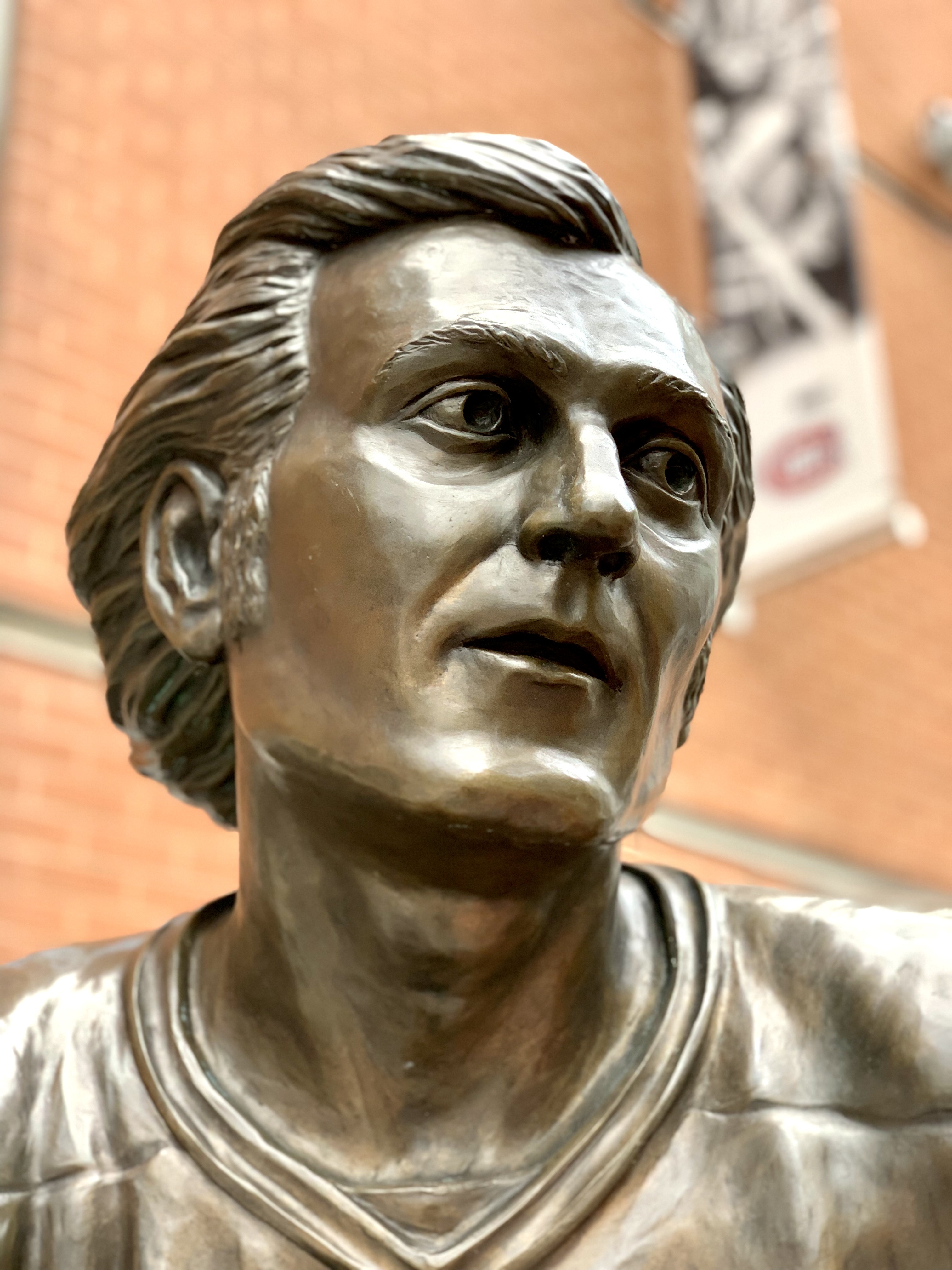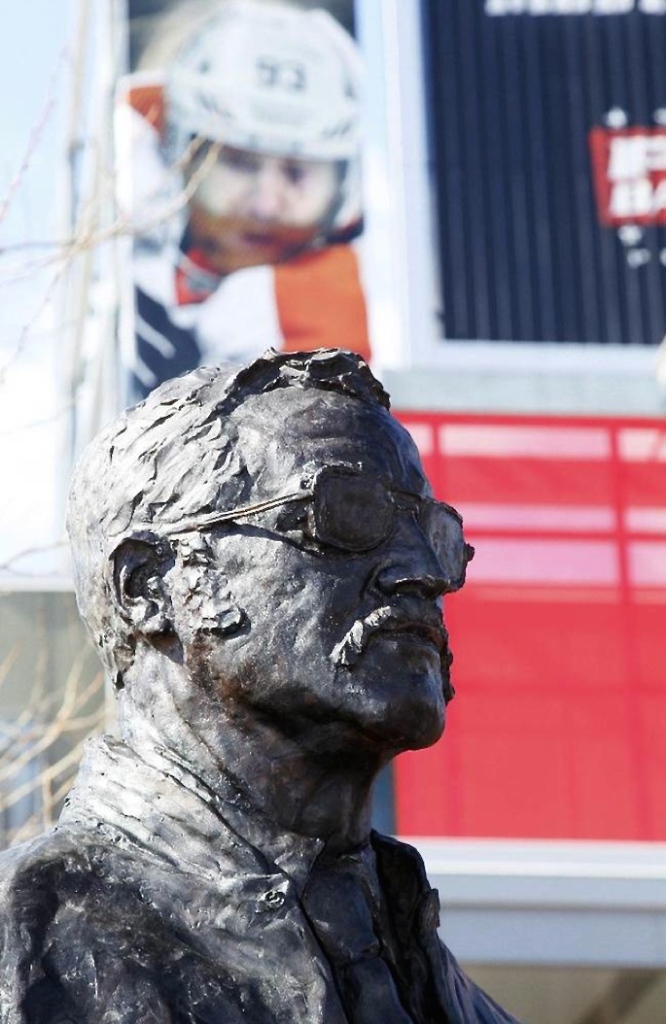
Bear With It: The Bruins’ distinctly mouse-looking mascot roams Boston Garden on the Thursday night of April 9, 1970, as the home team beat the New York Rangers 5-3 in a Stanley Cup quarter-final match-up. (Image: Frank O’Brien/Boston Globe via Getty Images)
A black cat followed Art Ross into his hotel room one Halloween but no, the coach and manager of the Boston Bruins wasn’t concerned that his luck was on the wane. Ross doesn’t seem have been even slightly spooked. In fact, he was all for claiming the cat for the Bruins cause, as a mascot.
This was in Saint John, New Brunswick, in October of 1934, when the Bruins were in town for the pre-season training camp. The hotel was the Admiral Beatty. The Ottawa Journal reported that the Bruins were trying to find the cat’s owner to secure permission to ship it back to Boston. That was a courtesy, really: the team fully intended on taking it. “Anyone proving ownership will have all his expenses paid to Boston to see the Bruins perform in the National Hockey league playdowns,” the Journal said, “if they reach that stage with the help of their new mascot.”
The Bruins had a great year, as it turned out, though whether it was cat-inspired or not is hard to confirm. At the end of the regular season, Boston finished first in the NHL’s four-team American Division standings, earning a bye into the playoff semi-finals. There they ran into the Toronto Maple Leafs, who’d topped the Canadian Division. (They topped the Bruins, too, to get to the Stanley Cup finals, where the Montreal Maroons topped them.)
I don’t know what happened to the cat from the Maritimes; Boston’s 1934 mascot sank out of sight before reaching Boston, if reach it he did.
What were the Bruins doing dabbling in felines? Shouldn’t a team that wears the bear and has, from its start in 1924, embraced a grizzly spirit, have been looking to ursine options to fill the role of mascot?
Short answer: the cat was anomalous, a one-off. Throughout Boston’s history, when it comes to mascots, the Bruins have mostly stayed true to their own, even if only the earliest of their bears was an authentic (as in live) animal. Over the course of their 99 NHL years, most of the bears the Bruins have trotted out to represent themselves have been either dead or faux.
Just a year before the cat caught Ross’ eye in New Brunswick, Boston had a bear on staff — or, at least, on site, at Boston Garden. This would seem to have been their first, arriving on the scene almost a decade after the team made its debut in the NHL. It was December of 1933, newspapers noted that a young bear, seven months old, had made his way south from Nashua, just up over the New Hampshire line. Not on his own. He’d been caught there, I guess, by someone named Robert Moore, who donated him to the Bruins. A black bear, apparently; it’s not entirely clear whether he (or she) was male or female.
Years later, in 1954, Art Ross remembered this, though I think he mixed up his dates: he thought it was 1928 that the bear arrived, the year the Boston Garden opened. “Somebody gave us a bear cub,” he told a Boston Herald reporter, “and Billy Banks used to show him off on a big chain but the bear grew nasty after a year or two and we gave him to a zoo.”

Threadworn: This hard-living bruin appeared on the cover of a team yearbook published for the 1927-28 season.
I haven’t seen any such nastiness otherwise documented. Lucky B does seem to have liked to roam, and that may have been a factor in his/her retirement. She — let’s go with that — made her NHL debut on a Tuesday night around this time of year at the Garden as the Bruins hosted the Montreal Canadiens.
It was an auspicious night in the United States: December 5, 1933 was also the night that Prohibition was repealed after 13 dry American years. I don’t think they’ve serving spirits at the Garden, but Lucky Bruin did make her debut, “cavorting on the ice unmindful of the crowd of 12,000.” NHL President Frank Calder was on hand, and it’s possible that he could have been involved in the pre-game ceremony during which Robert Moore handed over Lucky Bruin to Bruins’ captain Marty Barry with (as the Boston Globe said) “due formalities.”
Boston won that game, 5-2. Their bear went quiet for a bit, or at least unreported. It was the end of the month before he was back in the papers, featured as “feeling frisky” during a 2-2 tie that Boston and the Toronto Maple Leafs shared in on Tuesday, December 27.

Lucky Him/Her: That’s Bruins’ manager and coach Art Ross, I’m afraid, with the team’s poor, chained mascot in December of 1933. Garden attendant and bear wrangler Billy Banks is in the background.
Let loose on the ice in the intermission between first and second periods, “he romped around the length of the rink twice and then attempted fence climbing,” the Globe observed. “He did get over the fence once but was put back on the ice by a Garden attendant.”
In January, Lucky Bruin made what seems to have been her showing at a game that Boston lost 0-1 to the visiting Montreal Maroons. Still not clear on the bear’s gender, the Globe seems to have opted for inclusivity, switching it around within a single paragraph, a progressive choice, surely, for the day — unless it was unintended:
During the intermission between the second and third period, after making his usual tour of the rink, the bear stopped near the Bruin bench, hesitated a minute and then quick as a flash climbed over the low fence. The Bruins’ dentist from his seat in the front row was watching her every move, however, and just as Lucky Bruin landed on the other side of the fence, he grabbed the bear’s chain and held her until an attendant reached there.
He’s not named in the Globe game report but I think this would have been Dr. Charles W. Crowley. The attendant, I guess, was Billy Banks. Is this what Art Ross was thinking of as nastiness? Anyway, I haven’t found any further mention in the Boston papers of Lucky after that, so maybe she took her retirement mid-season.
In 1954, the Bruins were taking no chances on in-rink nastiness: the black bear they took delivery of that February was well and truly dead. I don’t know that this one had a name, but it was seven-feet tall, weighing 450 pounds. Someone had shot it near Millinocket, Maine, apparently, and taxidermied it.
Maine Governor Burton M. Cross presented it to Bruins’ owner Walter Brown ahead of a game against the Detroit Red Wings.
“I hope the bear will help to bring the Bruins luck,” said the Governor.
“I hope that luck goes to work tonight,” Brown said. The Bruins had lost seven in a row. With the bear encased in glass in the Garden lobby, they managed a 1-1 tie.
I don’t know how long the Maine bear kept his place; I’d like to imagine that he was still around in 1970 when Boston won another Stanley Cup, their first since 1941. Does anyone know?
The team did have a roaming bear by then, which is to say someone roaming the aisles of the old Garden in unnerving bear suit, as seen at the top of this post.

Winnie The Bruin: Hall Gill and the Bruins wore these bearish alternate sweaters in 1999-2000. The team’s ReverseRetro sweaters revived this bear in 2020. (Image: Classic Auctions)
The Bruins got a new rink in 1995, what’s now known as the TD Garden, and some point it gained a big bronze bear statue. The team says on its website that it has commissioned another one, too, to honour its alumni, with details of when it will be unveiled to follow. “The statue, which is in the shape of a Bruins bear, is being sculpted by Harry Weber, the same artist who previously sculpted and created the famous Bobby Orr statue that sits in front of TD Garden.”
Since 2000, the Bruins have had an official guy-in-a-fake-bear-suit mascot, the cartoonish Blades. The team held a contest to name him: Spokey, Bruiser, and Stanley Cub was some of the finalist. “A soft, furry guy with big teeth,” the Globe described him on his debut, at which time the Bruins, via community relations coordinator Heather Wright, made abundantly clear that Blades was strictly an off-ice member of staff and wouldn’t be donning skates to perform gimmicks, no way.
“Our game is very focussed on the game of hockey,” Wright told the Globe. “Blades is an addition to that. We added him to create a fun, more complete experience for our fans, particularly families. We expect he’ll be doing a lot of head-patting, handshaking, and hugging.”
In 2009, the Boston advertising agency Mullen crafted a popular and, shall we say, grittier multimedia campaign for the Bruins featuring yet another simulated bear. (You can view a compilation of the Mullen spots here.)
“The Bruins have their swagger back,” Greg Almeida, the copywriter on the file, told the Boston Globe, “and we wanted to come up with something that really brought that forth.”
“We actually modified the look of the bear a little bit,” said Jesse Blatz, the art director. “We furrowed his brown a little bit to make him look nasty. If you want, you can spend over $100,000 to rent a bear suit fort a commercial shoot. But the bear that we got, he’s not overly fancy. He’s a working man’s bear.”
(Image of Blades on ice flying his flag shows the aftermath of a Bruins victory over the New Jersey Devils at TD Garden on October 12, 2019. Image: Kathryn Riley/Getty Images)



















